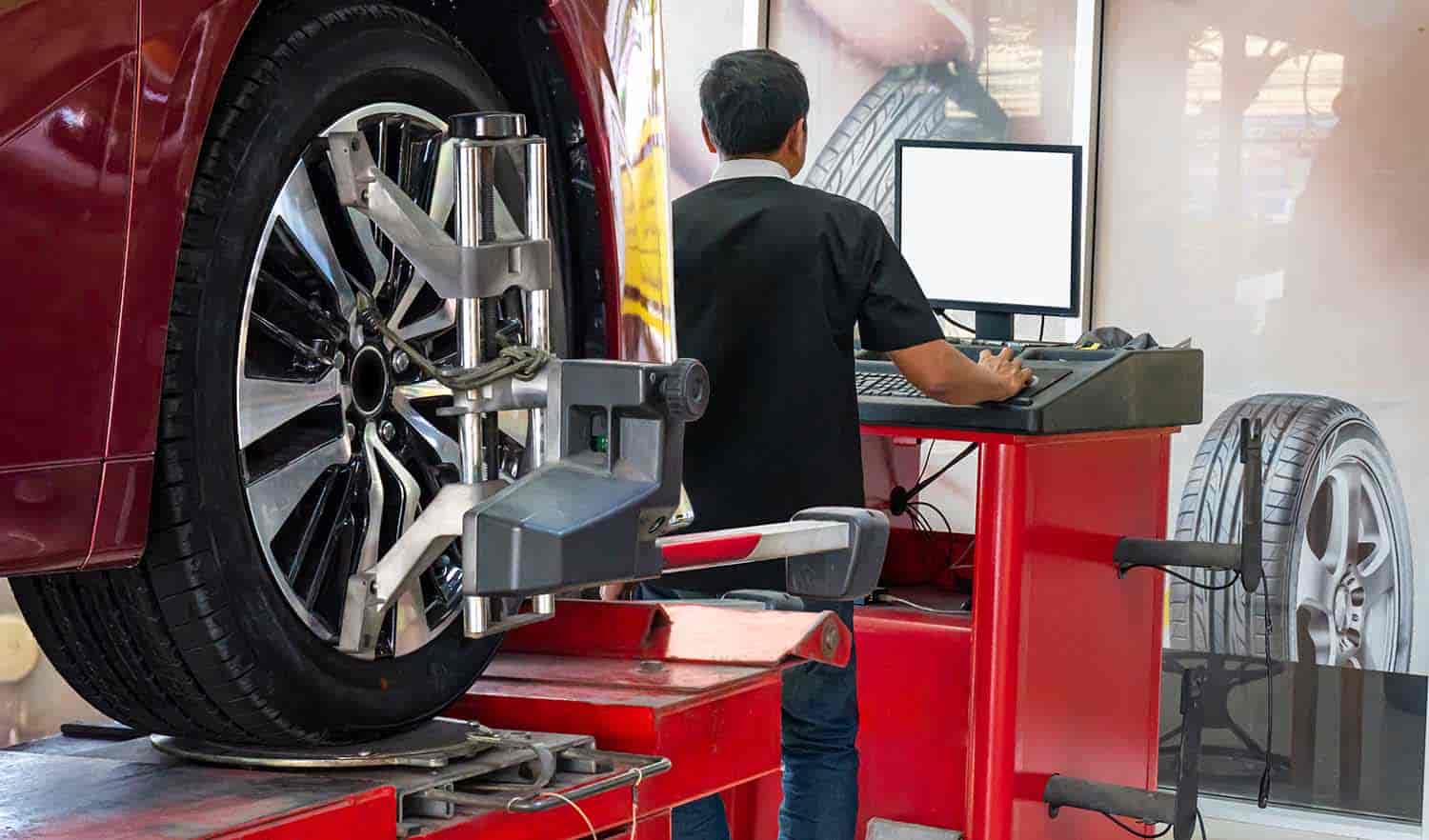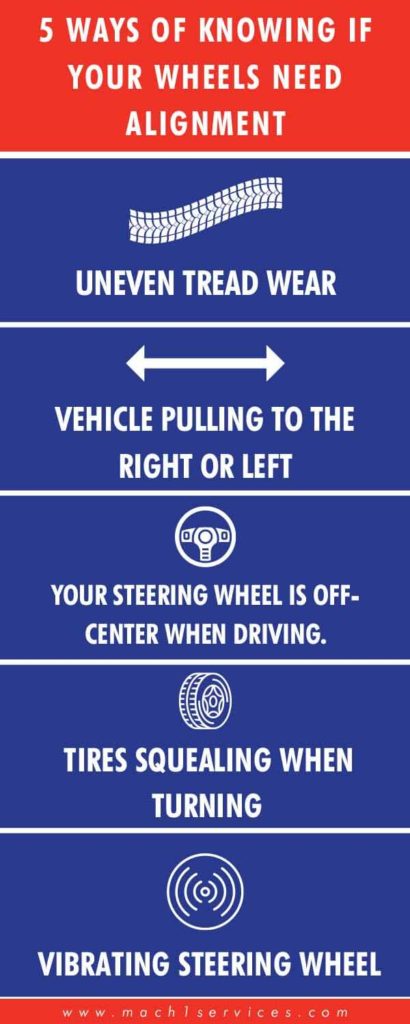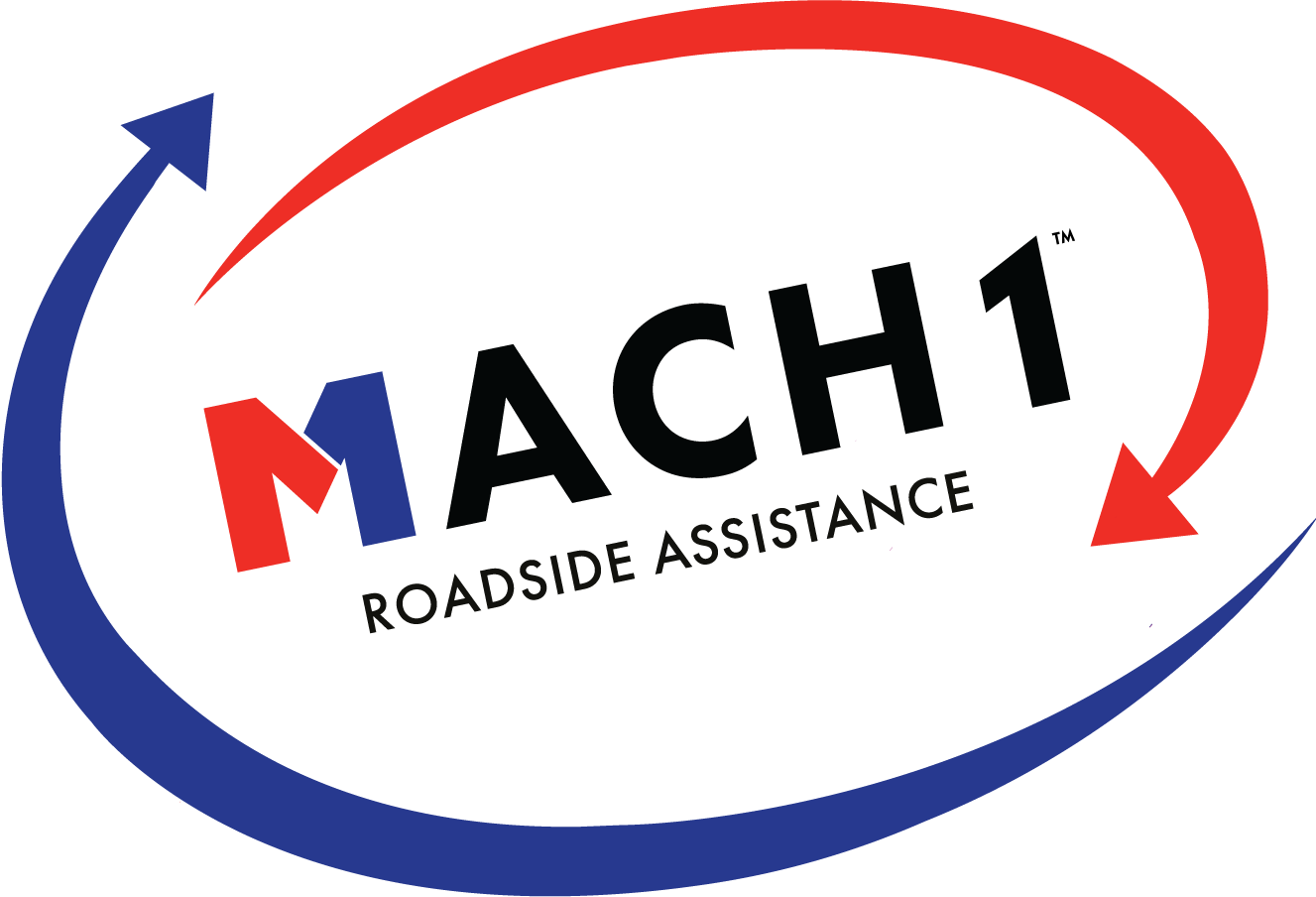
26 Jul 5 Ways Of Knowing If Your Wheels Need Alignment
Wheel alignment helps your tires last longer and perform properly. When your wheels are correctly aligned, you won’t hear that strange sound coming from your wheels. A wheel alignment will also keep your wheels from pulling in one direction.
When your wheels aren’t aligned, it can be dangerous as you can cause collisions by driving out of traffic lanes. It can also result in too much friction between your tires and the road leading to premature thinning of tires and loss of pressure. All this leads to poor road performance. Regularly, tire wear takes tens of thousands of miles. If your tire wears after a few months, you might need to check your wheel alignment.
When you buy a car, it always comes when it’s perfectly aligned according to its use. With time, the wheels become misaligned because of potholes on the road, an accident, or bumping a curb. You could also cause misalignment in your wheels by going too fast and knocking a bump.
Wear and tear also cause wheel misalignment. Parts like suspension springs wear out, and this may result in one side of your car seeming raised or unstable as you drive.
Some people change the car’s modifications to their preference forgetting about the car’s suspension. When changing your car’s height, you also need to put the car’s suspension into consideration. The vehicle is designed to work at a certain angle, and if you adjust the height of the car without adjusting its suspension, the car will be misaligned.
What is wheel alignment?
Wheel alignment makes sure that the tires are aligned according to the road and each other to make sure they match the manufacturer’s specifications. Tires alignment involves the adjustment of the vehicle’s suspension. A suspension is what connects the vehicle to its wheels. Proper alignment means adjusting the angles of the tires, which affects how they come in contact with the road.
What happens if your wheels aren’t aligned?
Lack of tire alignment can be dangerous.
- Accidents- Bad tire alignment will cause your vehicle to pull to the right or left, which is dangerous as it could result in an accident. When your wheels aren’t correctly aligned, this means that they aren’t facing the optimal direction. The more misaligned your wheels are, the less you can rely on your steering. Driving in a busy street or extreme weather conditions like rain or snow can make the situation more dangerous as it might cause an accident.
- Untimely tire wear- When your wheels aren’t appropriately aligned, the tires wear unevenly and quickly. Take a keen look at the threads on your tires. In a car with proper wheel alignment, the tires are worn out evenly and in consistent spots. Even though you must replace your tires frequently, proper wheel alignment helps keep that cost at bay. When your tires wear at the edges where they are most vulnerable, they can shred and cause severe damage to the wheel and axle.
- Too much fuel usage- The more your vehicle is trying to stay on the road, the more fuel it will use. Having proper wheel alignment could also save you money spent on fuel.
- Steering vibration- Lack of proper wheel alignment can cause the vehicle to vibrate and shake. The vibration of the steering wheel could also be a result of other significant problems that need an immediate response. When your steering keeps vibrating, it makes it uncomfortable to drive.
- Tire squeal- Misaligned tires could also cause your tires to squeal when you make turns or accelerate. Squealing of tires could also result from worn-out brake pads. You will need to have a mechanic check it out to determine which problem it could be.
How do you know if your wheels need an alignment?
There are different ways you can tell if your wheels need alignment. When you take your car to a technician, these are the things they will look at to know whether it’s alignment you need or not—the camber, toe, and caster.
Camber
Camber refers to the inward or outward angle of the tire viewed from the front of the vehicle. Too much inward or outward tilt of the wheels means they are misaligned and need to be adjusted. Worn-out wheel suspension parts like ball joints and bearings could contribute to camber misalignment.
When the top of the tires tilts away from the center of the vehicle, you have positive camber, while negative camber is when the top of your tires tilt inward. None is better than the other. But when you have positive camber, your vehicle has improved stability. Negative camber is mainly used by high-performance vehicles that need better cornering. The driver gets more control of the wheel when it’s in negative camber.
Using either positive camber or negative camber isn’t necessary because too much of either could affect many aspects of your vehicle. To know how your wheels should be aligned, check with your manufacturer for the vehicle’s wheels default settings.
Toe
Toe alignment is a reference to the extent to which your tires turn inward or outward when viewed from above. You can picture this in terms of you looking down at your feet or a bird’s view. When the wheels of your vehicle are facing each other, it is called toe-in alignment, and toe-out alignment is when your wheels have an outward alignment. Both scenarios require adjustment.
Toe alignment results from the difference between the track widths measured at the leading and trailing edges of the tires. As much as your wheels need to face forward when driving, toeing can be beneficial depending on the type of car you’re driving.
Regular cars use straight-facing wheels, while racing cars use toe-out to enhance turning ability. Basic passenger cars use toe-in because there is no need to turn corners quickly. Toe-in discourages turning because it promotes stability in the wheels.
Caster
The angle of your caster helps in balancing the steering, cornering, and stability. Caster is determined by the angle of your steering axis from the sideways view of your vehicle. A positive caster means the steering axis will tilt towards the driver, while a negative caster means that the steering axis will lean towards the front of your vehicle.
Caster does not affect the tire’s wear, but it helps in how much steering effort you will need to balance your wheels, high-speed stability, and the front-end cornering effectiveness. Standard cars don’t need adjustment in the caster since they come with default settings. But if you’ve had your car customized, you might need to check your caster to make sure it’s okay.
5 Ways of Knowing Your Wheels Need Alignment
 When driving your car, there are several ways that you can determine whether your wheels are correctly aligned or not.
When driving your car, there are several ways that you can determine whether your wheels are correctly aligned or not.
1. Uneven tread wear
Scrutinize your car to see if the tear and wear are equal between all wheels. When wheels are correctly aligned, they experience an equal amount of tear. When you find that some wheels are worn out on different sides or angles, they aren’t correctly aligned. Jagged tears of the tires will result in you changing the wheels every few months, which can cause a financial strain.
A car that has properly aligned wheels has wear in treads at similar angles. To check for this, you can measure the tread depth on each wheel and compare them to each other. Wheels that are properly aligned have the same rubber depth on each tire.
2. Vehicle pulling to the right or left
If you notice your wheels pulling in a different direction than you’re steering them to, this might be a result of your wheels not being aligned. You might not view this as a problem, but when you’re driving in the rain, your car may hydroplane. When you hydroplane, your car loses traction with the pavement, and you might switch from the lane you’re in, causing an accident.
You can test this by taking your hands off the steering wheel when driving on a straight path to see whether it goes straight forward or moves in a different direction. When it does this more than once, it means you might require wheel alignment. The more your car pulls out of a straight line, the more unaligned the wheels are.
3. Your steering wheel is off-center when driving.
When your steering wheel is crooked, it means that your vehicle is misaligned. The steering wheel was designed to be at the dead center of the vehicle. When driving down a straight road, check the logo in the middle of the steering to know whether it is misaligned or not.
Wheel misalignment could also cause your steering wheel to be loose. A loose steering wheel will cause you not to directly feel your wheels turning to the direction you’re steering towards. But if you feel like you’re turning the steering so often without much tire movement, this means you need to align your wheels.
4. Tires squealing when turning
When tires are misaligned, they wear them at different rates and angles. When you’re turning a corner or accelerating, you might notice a squeal in the tires because they aren’t aligned. Worn-out brake pads could also cause tire squealing. It is best if your mechanic checks this problem as soon as possible to prevent further damage.
5. Vibrating steering wheel
Bad alignment can cause your steering to vibrate, making driving uncomfortable. When accelerating or driving, your steering wheel should not vibrate to the point you feel it in your hands. Many problems could result in your steering wheel vibrating and among them is misalignment. You need your mechanic to check your vehicle and determine what it could be.
Final Words
Wheel misalignment means that you will need to restore your wheel’s position to factory settings. The way your car is designed when you buy it is intended to perform flawlessly for its use. We tend to hit potholes, bumps, curbs, and unfortunately, get in an accident with time. These may not be major at first, but with time it affects the alignment of the vehicle.
When you know that your wheels need alignment due to the symptoms mentioned above, you need to go to a professional, and they will check your car and adjust all the wheels to function as the manufacturer meant them to.
Aligning your wheels will save you a lot of money that you will spend on fuel and buying tires. If your car has any of the above symptoms, have it checked as soon as you can.
